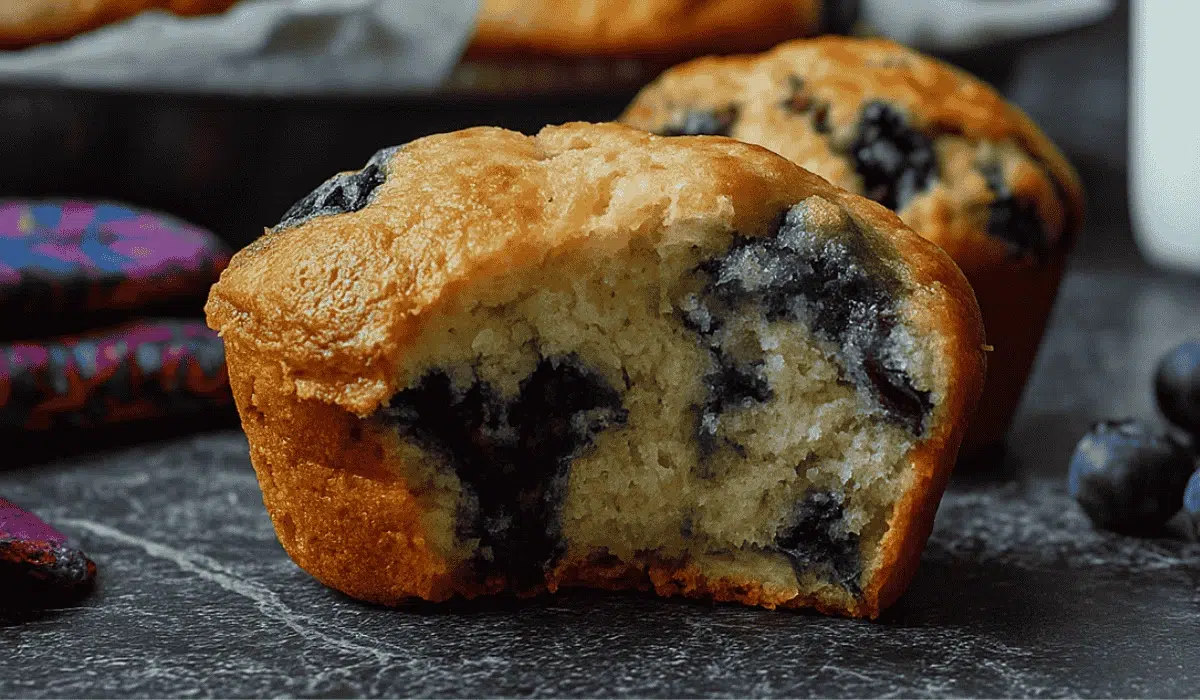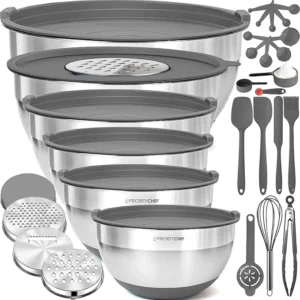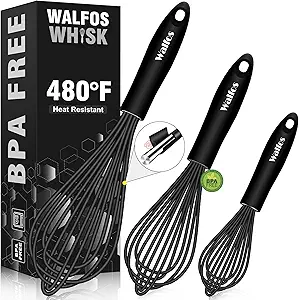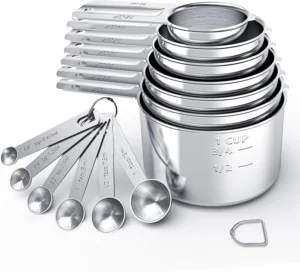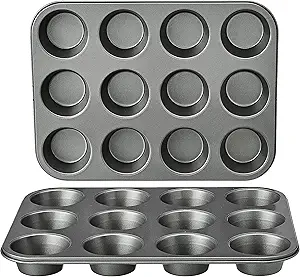I didn’t always bake with yogurt. One day, short on milk, I reached for a tub of plain Greek yogurt and the result surprised me. These blueberry muffins turned out softer, richer, and somehow fresher than the usual kind. This blueberry muffin recipe with yogurt quickly became a staple in our kitchen. The batter comes together in minutes, no mixer needed, and the muffins rise with a golden dome and tender crumb. Whether you’re baking for family, friends, or just yourself, this recipe makes muffins that feel like something special without trying too hard.
Table of Contents
Why You’ll Love This Recipe
- Moist Every Time: Yogurt does the heavy lifting here, locking in moisture so your muffins stay soft for days without turning gummy or dense.
- Simple, Familiar Ingredients: Everything you need is probably already in your kitchen. No buttermilk, no specialty flours just basics that work.
- Easy to Make: No mixer required. Just a couple of bowls and a spoon. This is the kind of recipe you can pull off even on a busy weekday morning.
- Versatile and Family-Friendly:Bake them plain or add a streusel topping. Swap in lemon zest, try frozen blueberries, or make them mini for lunchboxes.
- Better Than Bakery Muffins: With a naturally tangy base and real berries, these taste homemade in the best way tender, balanced, and not overly sweet.
These muffins don’t just fill the kitchen with that warm, comforting smell they offer a reliable, delicious bite every time. It’s the kind of recipe you’ll come back to again and again.
Ingredients Needed For Blueberry Muffin Recipe With Yogurt
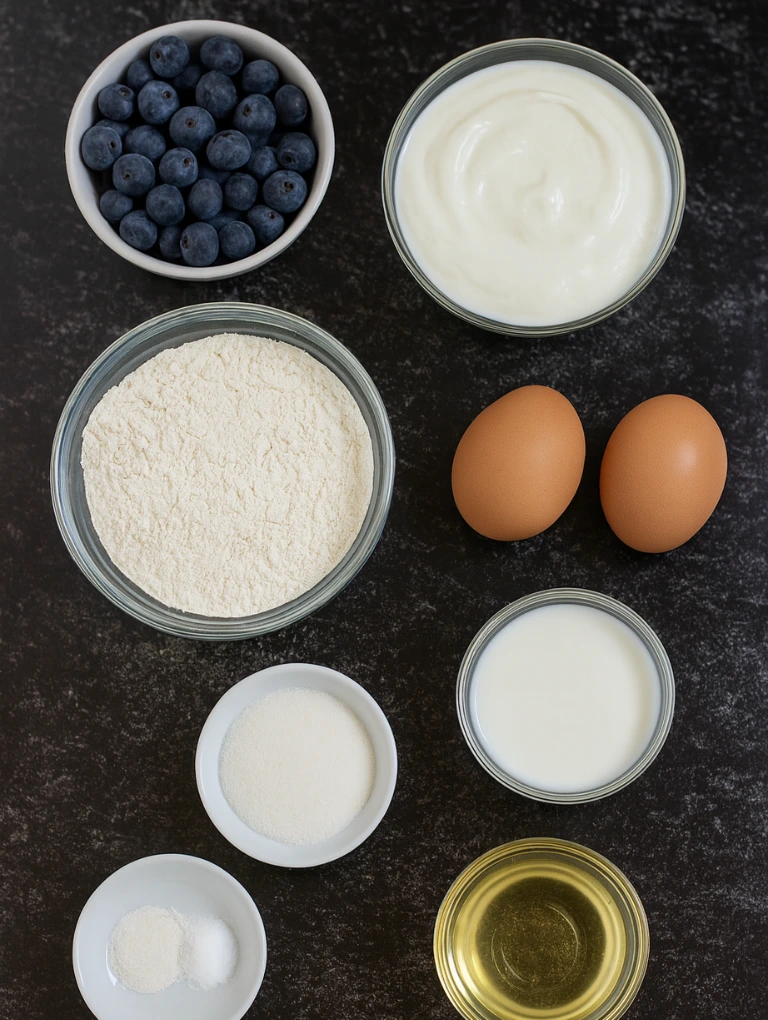
Here’s what you’ll need to make these moist and flavorful blueberry muffins with yogurt. I’ve added notes to help you get the best results and to offer easy swaps if needed.
Dry Ingredients
- 2½ cups all-purpose flour: Gives the muffins structure. You can substitute cake flour for a more delicate texture, or use white whole wheat flour for a wholesome twist.
- 1 tablespoon baking powder: Helps the muffins rise tall and fluffy.
- ½ teaspoon baking soda: Works with the yogurt’s acidity to create a tender crumb.
- ½ teaspoon salt: Balances the sweetness and enhances the flavor.
- ½ cup granulated sugar: Just enough to sweeten without overpowering the berries.
Wet Ingredients
- 2 large eggs, lightly beaten: Use at room temperature for better mixing and even texture.
- ⅔ cup neutral oil: Canola or light olive oil work well. Oil keeps the crumb moist longer than butter.
- 1 cup plain Greek yogurt: Whole milk Greek yogurt is best for richness. Low-fat can work, but results will be slightly less creamy.
- ¼ to ½ cup milk: Start with ¼ cup; add more only if the batter feels too thick. Whole or 2% milk both work.
Add-Ins
- 1½ cups blueberries: Fresh or frozen both work. If using frozen, don’t thaw first. Toss in a teaspoon of flour to prevent sinking.
- Extra sugar, for sprinkling (optional): Adds a light crunch on top, especially nice if skipping a streusel topping.
Ingredient Notes & Substitutions
- Gluten-Free? Use a 1:1 gluten-free flour blend with xanthan gum.
- Dairy-Free? Swap the yogurt for a plant-based alternative (unsweetened almond or coconut yogurt) and use a non-dairy milk like oat or soy.
- Budget Tip: You can use regular plain yogurt instead of Greek. Just reduce the milk slightly since it’s thinner.
How to Make Blueberry Muffin Recipe With Yogurt
These muffins come together quickly, with no mixer needed. The steps below are written to guide you like a friend in the kitchen, especially if it’s your first time baking with yogurt.
Step 1: Preheat the oven
Heat your oven to 375°F (190°C). Get your muffin tin ready by lining it with paper cups or greasing it lightly. Always start with a hot oven for the best rise.
Step 2: Stir together the dry ingredients
Grab a large mixing bowl. Add the flour, baking powder, baking soda, salt, and sugar. Give it all a good stir with a whisk or fork. You want everything evenly mixed so the muffins rise evenly.

Step 3: Mix the wet ingredients
In another bowl or a large measuring cup, combine the eggs, oil, Greek yogurt, and milk. Whisk until smooth and creamy. If the yogurt is very thick, don’t worry it will thin out once you stir everything together.
Step 4: Combine the wet and dry
Pour the wet mix into the dry ingredients. Use a spatula or wooden spoon to stir until it just comes together. Don’t overmix. The batter should look thick and a little lumpy. That’s what gives muffins their soft crumb.
Step 5: Fold in the blueberries
Toss your blueberries with a teaspoon of flour (this helps keep them from sinking). Gently fold them into the batter just a few turns of the spoon is enough. You don’t want streaks of purple everywhere.
Step 6: Fill the muffin cups
Scoop the batter into the muffin tin. Fill each cup nearly to the top. For a nice golden top with a bit of crunch, sprinkle a little sugar over each one.

Step 7: Bake
Place the tin in the oven and bake for 17 to 20 minutes. Check them at 17 minutes by poking one with a toothpick it should come out clean or with a few moist crumbs.
Step 8: Cool and enjoy
Let the muffins sit in the pan for 5 minutes, then move them to a wire rack. This helps keep the bottoms from getting soggy. They’re best slightly warm but just as good the next day.
Pro Tips & Troubleshooting
Even simple muffin recipes have their secrets. These tips help you bake like you’ve done it a hundred times even if it’s your first go.
Expert Tips for Perfect Muffins
- Use room-temperature eggs and yogurt
Cold ingredients don’t mix as smoothly. Let them sit out for 10–15 minutes before you start. This small step makes a big difference in texture. - Don’t overmix the batter
Once the wet meets the dry, stir gently and stop as soon as you don’t see dry flour. Overmixing activates gluten, which leads to dense, chewy muffins. - Toss blueberries with a little flour
Coating the berries in a teaspoon of flour keeps them from sinking to the bottom. It also helps them stay evenly distributed. - Start with thick batter
A thick batter helps the muffins rise high. If it feels too stiff, add just a splash of milk but don’t aim for a pourable batter. - Fill muffin cups almost to the top
For domed, bakery-style muffins, fill each cup nearly full. You’ll get tall, golden tops without overflow.
Common Mistakes to Avoid
- Using low-fat yogurt
It can make your muffins dry. Whole milk Greek yogurt gives the best texture and flavor. - Baking at the wrong temperature
Too low, and your muffins won’t rise. Too high, and the outside burns before the center cooks. Stick with 375°F (190°C). - Opening the oven too early
Don’t peek before 15 minutes. Sudden temperature drops can collapse the muffins. - Underbaking
Muffins should feel springy on top and pass the toothpick test. A sticky center means they need more time.
Bonus Tip:
Try sprinkling a mix of raw sugar and lemon zest on top before baking. It adds a subtle crunch and a pop of citrus that makes these muffins unforgettable.
Serving, Storage & Variations
These muffins are easy to love right out of the oven but they’re also flexible enough to enjoy days later, or reinvent with a few small changes.
How to Serve
- Warm from the oven: Let them cool just enough to handle, then enjoy as-is or with a little butter.
- With coffee or tea: These pair beautifully with a black cup of coffee or something citrusy like Earl Grey.
- Split and toasted: Try halving and toasting them lightly the next day. Add a spoonful of jam or a swipe of cream cheese.
- Kid-friendly snack: Pack in a lunchbox or serve with a side of fresh fruit for an after-school treat.
Storage Tips
- At room temperature: Store muffins in an airtight container lined with a paper towel. They’ll stay fresh for about 2–3 days.
- In the fridge: If your kitchen’s warm or humid, refrigerate them for up to 5 days. Just let them come to room temp or warm them slightly before serving.
- Freezing instructions: Once completely cool, wrap muffins individually and freeze in a sealed bag for up to 3 months.The USDA notes that while frozen foods remain safe indefinitely at 0°F, quality is best when used within a few months.For more on best practices, refer to the USDA’s guide to freezing and food safety.
Easy Variations
- Lemon-blueberry: Add 1 tablespoon of lemon zest to the batter for a bright, citrusy note.
- Cinnamon swirl: Mix 2 tablespoons brown sugar with ½ teaspoon cinnamon and swirl into each muffin before baking.
- Streusel topping: Combine 2 tablespoons flour, 2 tablespoons brown sugar, and 1 tablespoon melted butter. Sprinkle over batter for a crumbly top.
- Mini muffins: Use a mini muffin tin and reduce baking time to 10–12 minutes. Great for parties or small hands.
Looking for more blueberry muffin ideas? Try our rich and nutty Blueberry Pistachio Muffins or the quick and easy Bisquick Blueberry Muffins. For even more inspiration, visit our full guide: Blueberry Muffins Recipe.
Nutritional Information
Here’s a breakdown of what you’re getting in each muffin calculated based on standard ingredients and one serving out of a batch of 12.
Note: For the most accurate numbers, use a recipe calculator like MyFitnessPal or Cronometer if you modify ingredients or portion size.
Macronutrients (Per Muffin)
| Nutrient | Amount |
| Calories | 272 kcal |
| Carbohydrates | 32 g |
| Protein | 5 g |
| Fat | 13 g |
| Saturated Fat | 1 g |
| Cholesterol | 28 mg |
| Fiber | 1 g |
| Sugar | 11 g |
Micronutrients (Per Muffin)
| Nutrient | Amount |
| Sodium | 65 mg |
| Potassium | 183 mg |
| Calcium | 77 mg |
| Iron | 1.5 mg |
| Vitamin A | 60 IU |
| Vitamin C | 1.8 mg |
Why it matters:
Yogurt adds protein, calcium, and gut-friendly probiotics as supported by this NCBI article on fruit and yogurt synergy.
Blueberries are rich in antioxidants like anthocyanins, which may support cardiovascular health according to this NCBI review.
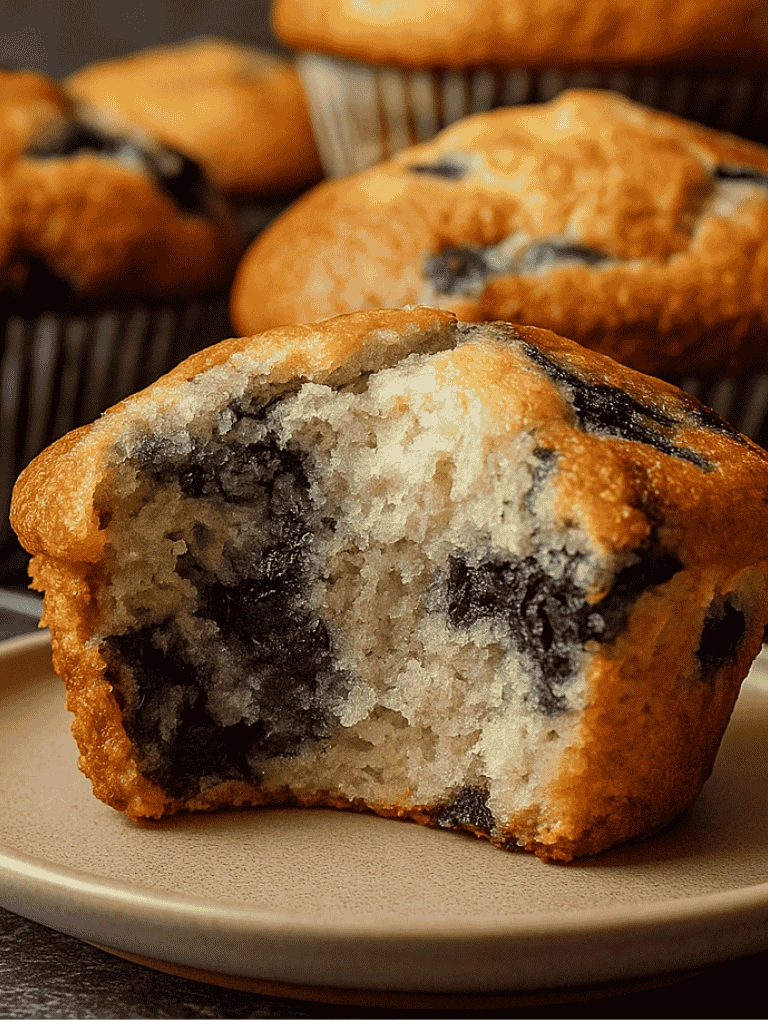
Conclusion
There’s a reason this blueberry muffin recipe with yogurt earns a permanent spot in your baking rotation. It’s simple, reliable, and delivers moist, flavorful results every time. The yogurt keeps the crumb soft without making the muffins heavy, while the blueberries add natural sweetness and brightness to every bite.
Whether you’re baking for a quiet morning, a busy week, or sharing with friends, this recipe fits the moment. No fancy tricks just thoughtful ingredients and a few key steps done right.
Frequently Asked Questions (FAQ)
What does adding yogurt to muffins do?
Yogurt adds moisture, richness, and tenderness. Its natural acidity helps activate baking soda, giving muffins a better rise and lighter crumb. It also adds protein and a subtle tang that balances sweetness.
Can you use yogurt in place of milk in muffins?
Yes, you can. Plain yogurt (especially Greek) can be substituted for milk in most muffin recipes. You may need to thin it slightly with a bit of water or milk if the batter seems too thick. Yogurt adds creaminess and helps prevent dry results.
Is sour cream or yogurt better in muffins?
Both work well, but Greek yogurt is often a healthier choice with more protein and less fat. Sour cream adds a bit more richness and a softer texture, while yogurt keeps things lighter and adds a slight tang.
What is the trick for blueberry muffins?
There are a few:
- Toss blueberries in a little flour to keep them from sinking.
- Use room temperature ingredients for an even batter.
- Don’t overmix the batter should be lumpy.
- Fill muffin cups nearly full for a nice domed top.
Can I use yogurt instead of oil in muffin mix?
You can replace some or all of the oil with yogurt, but it will change the texture. Muffins may become denser and less tender. If you want to cut oil, try replacing half with yogurt and see how it affects the result.
What is the purpose of yogurt in baking?
Yogurt adds fat, acidity, and moisture. This improves texture, helps baked goods rise, and adds a slight tang that enhances flavor. It’s especially helpful in recipes without much butter or oil.

